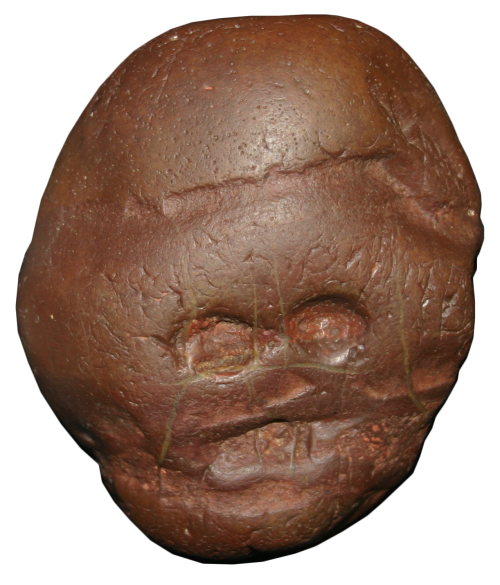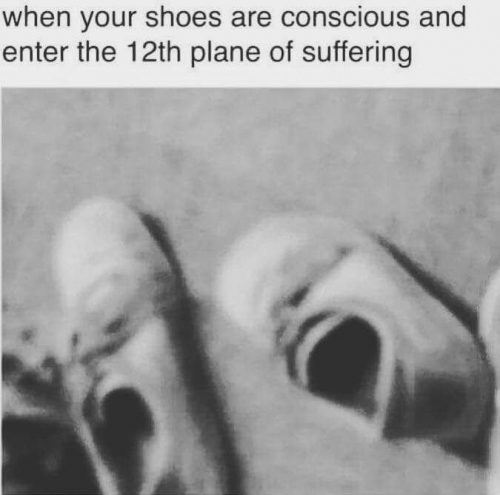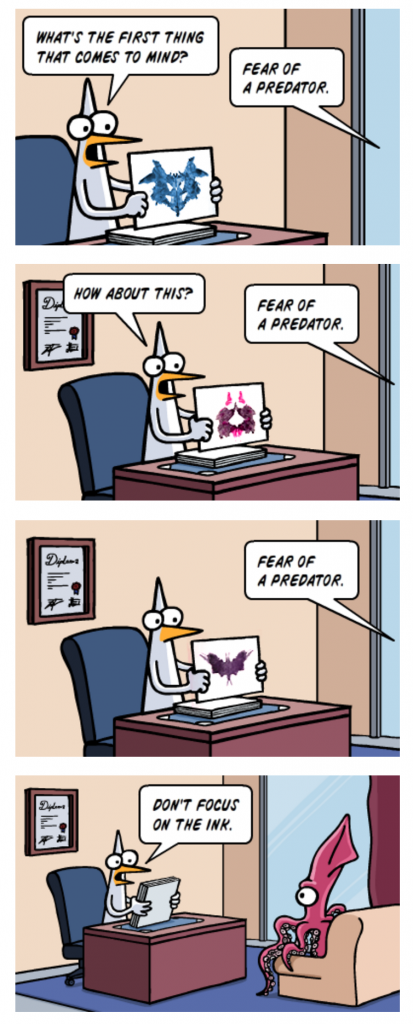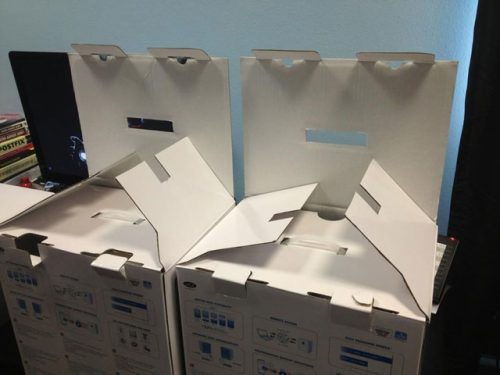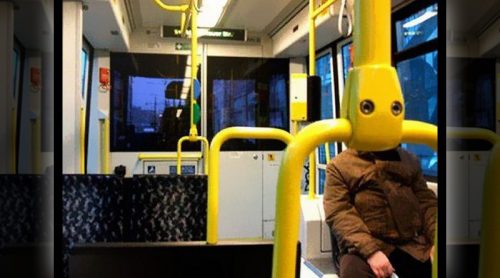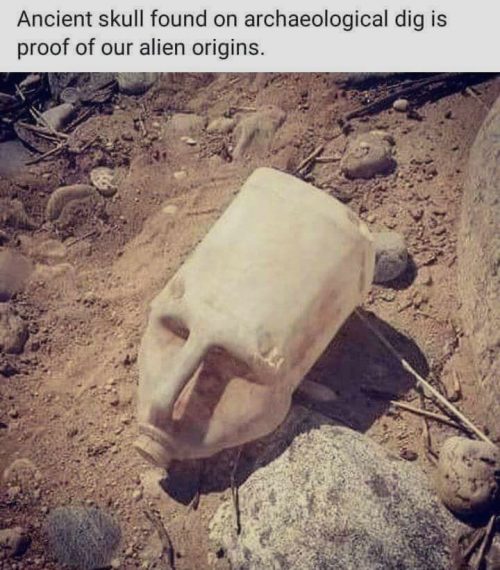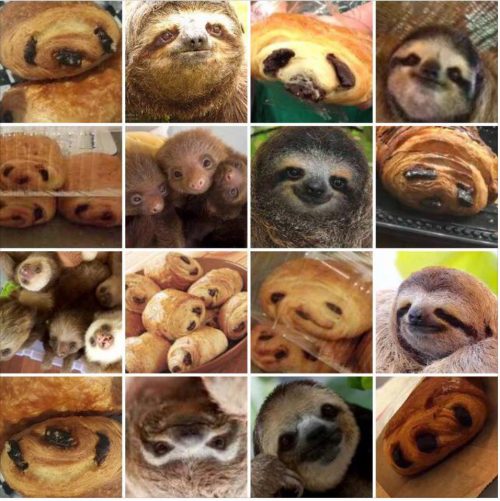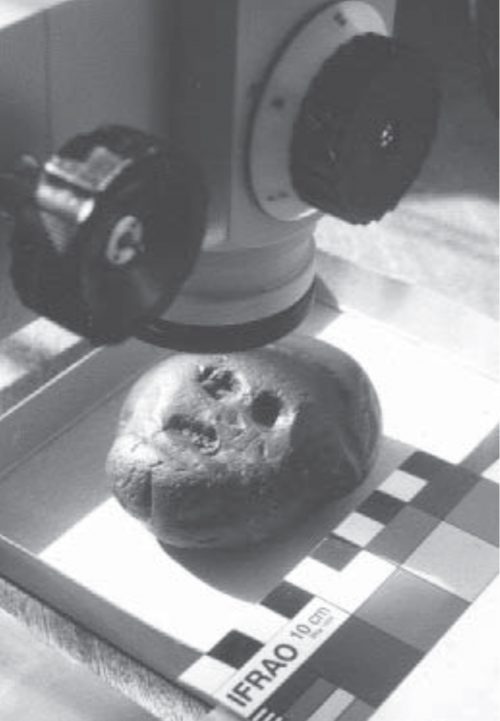This is the Makapansgat Pebble. It’s a rock, with a face, and a name. It was found in the Makapan Valley in South Africa in 1925, in a cave that was inhabited by a now-extinct hominid ancestor of the human species, Australopithecus africanus, two and a half million years ago. We know that the pebble’s eyes and mouth were carved out by running water and neighbouring pebbles in a riverbed, rather than by hands. So it’s an image that was forged without any human-like invention or intention. But the cave where it was left is many miles away from any possible natural source, so paleo-anthropologists have speculated that it was picked up and transported, by someone who recognised the chance appearance of a face looking back.
The Natural History Museum in London identifies the Makapansgat Pebble as “perhaps the most ancient art object in the world.” The implication here is that it wasn’t art when it was sitting unnoticed in the river—but when it was pointed to, when it was picked out and displaced, it moved into the realm of artistry. If we accept this, we can say that art doesn’t begin with an act of creating something out of nothing, but with a moment of recognition that is actually a misrecognition: seeing a face where it isn’t, perceiving things as they aren’t. It isn’t inventing something new from scratch; it’s responding to what is already present, and treating it as something else.
I want to read into this capacity (or necessity) we have for reading into things. What does it mean that we can perceive more than what’s there? How much does all language—and all thinking and all meaning-making— depend on our ability to apprehend one thing in another thing? To what extent does perception always bring projective baggage along with it? What are the dangers and predicaments involved with the interpretative projections of our perceptions? And how might they be developed as part of critically engaged practices? Given that every critique of present conditions depends on the basic premise that reality could be otherwise, how can active misrecognition be deployed as a deliberately disobedient mode of looking, where we nurture our capacity to see beyond what it is that we are supposed to see?
In her 1926 essay On Being Ill, a bed-bound Virginia Woolf is looking up at the sky and watching its incessant inventions. “This then has been going on all this time without our knowing it!” she remarks, shocked by the endless array of shapes and scenarios performed by the clouds. “Someone should write to The Times about it,” she decides. “One should not let this gigantic cinema play perpetually to an empty house.”1 There are two factors contributing to her experiencing the sky’s imagery as if for the first time. One is that she has to remain supine, for an extended duration, giving her body a spatial and temporal orientation towards the sky, which is something that isn’t granted to those upright bodies rushing about the city streets. The second contributing factor is the dis-orientation of illness; this is a text about the warped but enhanced sensitivity that can be brought on when we are unwell. Woolf writes of the “mystic quality” that words can come to possess when language is rendered incomprehensible; as when feverish or otherwise delirious states take us to the edges of meaning, where other meanings might emerge.2
Hallucination can be a tricky thing to ascertain the boundaries of, as it will often arise from a combination of external reality with internal processing, and it can overlap with simple misperception. But the perceptual disturbances and persecutory delusions that can be experienced with psychosis or schizophrenia, for example, are largely beyond the bounds of what I want to consider here. There are psychological conditions in which hallucinations are involuntary and harrowing (Woolf wrote in her suicide note of hearing voices)—and then there are much more general experiences of mis-reading or actively over-reading an external stimulus, such as when we ‘see’ faces or animals in the clouds. We might be especially attuned to this sort of over-reading of random details when we are in particular states (when we’re feverish, when we’re on psychedelics, when we’re children, when we’re sleep deprived, when we’re socially anxious)—but we also do it all the time, because perception involves not only the passive reception of external stimulus but also aspects of our own memories and anticipations. To some degree, it is always interpretative and imaginative.
The word ‘pareidolia’ is used for forms that appear to us in places where they were not intentionally inscribed. Some of my personal favourites include: the profile of Mahatma Gandhi that was spotted on the surface of Mars; the partially eaten, decade-old toasted cheese sandwich said to bear an image of the Virgin Mary, which sold on eBay for US $28,000 in 2004; the Mother Theresa cinnamon bun; the chicken nugget that looks like George Washington; the house that looks like Hitler; the videos on YouTube showing Vladimir Putin’s face momentarily appear out of a flock of birds flying over New York City. Whether attributed to human hoax, natural accident, or some divine or paranormal force, all of these allegedly unauthored images can complicate distinctions between design and chance; real and imagined; made and found—reminding us that meaning isn’t something fixed inside the object of observation, but something that emerges from the attentive encounter with it.
‘Pareidolia’ comes from the Greek roots para for ‘beyond’ and eidon for ‘image’—suggesting images beyond images, appearances in excess of themselves. And pareidolic vision is something that can be actively applied, as a way to train the imagination. In his Treatise on Painting, for instance, Leonardo da Vinci told his disciples to look at stains and smudges on dirty walls, or random patterns in rock formations, and to discover in them all sorts of fantastic imagery, such as mountainous landscapes, detailed battle scenes, strange costumes and monstrous faces. Through contemplation of the clouds, or the mud, or the ashes from the fire, he promised, one could “bring out the genius” from “the jumble of things.”
This sort of seeing beyond the image or seeing the image beyond has also been at work in the more wide-spread practices of divination, fortune telling, scrying and the like. One of the most ancient and far-reaching of these practices is tessaeography, the reading of tea leaves or coffee or wine sediments left in cups. But there are countless other techniques, including, for instance, meilomancy (divination by moles), odontomancy (divination by teeth), amathomancy (divination by patterns in dust, dirt, sand or ashes), ornithomancy (divination by birds), capnomancy (divination by smoke), uromancy (divination by urine), urticariaomancy (divination by itches), tyromancy (divination by cheese), macharomancy (divination by swords or knives), driromancy (divination by dripping blood) and styramancy (divination by the reading of patterns left in chewing gum). All of these methods rely on the active and projective nature of perception, and affirm that with the right attunement of attention, anything can be read.
In the early twentieth century, the capacity we have to see things as they aren’t would become the basis of Swiss psychoanalyst Hermann Rorschach’s inkblot test, where subjects are asked to describe/ interpret what they see in a series of cards showing abstract blots of ink. Butterflies, masks, animal hides and vulvas are some of the things test subjects most often ‘recognise’ in the symmetrical blots, but each of the cards was conceived as a site of productive ambiguity. The pictures are effective only insofar as they carry no intended, or intrinsic, or universally agreed-upon, meaning—and can thus catch whatever is projected onto them. “What might this be?” is the question the analyst is supposed to ask the subject upon presentation of each new meaningless inkblot. Not “what is this?”, but “what might this be?”
Pareidolic vision is related to the more general phenomenon known as ‘apophenia’, which is the (not necessarily optical) perception of meanings or connections in random configurations. And like the Rorschach Technique, the neologisms ‘apophenia’ and ‘pareidolia’ both come out of modern psychology—particularly from the study and diagnosis of schizophrenia. But, as we have seen, the relevance of the pareidolic principal is much older and much broader than the pinpointing of the pathologised individual of western modernity. ‘Seeing’ always involves some degree of ‘reading’, and, as Marina Warner has observed, the Rorschach Technique can be understood as simply a scientisation of the existing divination methods that were based on the interpretation of seemingly random data which has no essential or universally accessible significance.3
In an inkblot test, pareidolic perception is supposed to go in both directions, with the subject reading into the shapes and arrangements in order to see more than just ink on the surface of a page—and the analyst then reading into the subject’s responses, interpreting the interpretations in order to access more than just what is consciously presented at a surface level by the subject. In fact, psychoanalysis—as a clinical practice and as a discourse—has always been thoroughly apophenic. We can think here of Freud’s interpretations of dream images, where we are told that all weapons, tools, machines, umbrellas, neckties and nail-files are actually penises—as are mountains, women’s hats, children, lizards and younger brothers.4 We can also think of the Jungian principle of synchronicity, where causally disconnected events are to be read as nonetheless meaningfully related to each other. In a psychoanalytic session, the shrink is supposed to be attentive to otherwise overlooked minor details, and to the links that can be drawn between them. She reads into what seems to be random, and doesn’t allow for things to be taken as arbitrary.
This mode of reading where the insignificant is made to signify is also clearly indispensable to the building of paranoic conspiracy theories—and indeed, in the same text where Freud forms a dubious causal link between paranoia and repressed homosexuality, he also articulates his notion of paranoia as a model for psychoanalytic theorising itself. Later, Paul Ricœur would put Freud in the company of Marx and Nietzsche as the three “masters of suspicion,”5 whose work would usher in what Ricœur identified as a modern school of hermeneutics, wherein the interpreter is suspicious of the intended, established, or immediately legible meanings of things, and looks instead for what else those things might mean—and for what they might exclude or cover up.
One critical project where a conspiratorial imaginary has succeeded with a crucial diagnosis of a previously unnamed condition is feminism, which has long been geared towards apprehending and describing patriarchy as a sprawling system which organises and permeates all aspects of reality, but which could otherwise go undetected in its vastness. This is a point observed by Sianne Ngai in her article Bad Timing (A Sequel): Paranoia, Feminism, and Poetry, in which she looks at reclaiming and reformulating paranoia as a tool for explicitly feminist thought and cultural production. As Ngai writes, terms like ‘patriarchy’ and ‘patriarchy-capitalism,’ “which refer to monolithic, yet amorphously-delimited and fundamentally abstract, value-based systems,” remain indispensable for critical languages that are able to grapple with the realities of our contemporary condition.6
Ngai posits that the paranoic-conspiratorial mode is particularly adept at zooming out from one historical trajectory and looking at what else we can see happening at the same time. This is a manoeuvre that can be extremely revealing not just for critical intervention in late capitalist culture but also as part of a historical methodology, as in Silvia Federici’s Caliban and the Witch, where she shows how completely intertwined the history of witch-hunting in Europe is with the simultaneous implementation of capitalist logics in the transition away from feudalism. This was a seriously under-acknowledged correlation, which Federici draws out in convincing detail through appropriately applied suspicion, an attunement to the ‘bigger picture’, and rigorous pattern recognition.7
But, as productive as these paranoic modes of seeking and organising knowledge can be, the instances where the conspiracy theories match up with the actual conspiracies are rare, and the field is rife with reactionary politics. As several writers on the topic of paranoia in political discourse have observed, it can be claimed just as easily by the right as by the left.8 Suspicion can be appropriately directed towards ruling class ideology, for instance, but suspicion can also be deeply xenophobic. It depends on who’s using it and what their motivations are—and in particular on whether they’re up for real structural critique, or whether they’re simply on the hunt for individual monsters to scapegoat.
As Karl Popper observed in his 1945 book The Open Society and Its Enemies, conspiracy theories have often tended to emerge where fear-based tribalist and nationalist mythologies take hold.9 Quite apart from marking a healthy questioning of the official narratives or a non-acceptance of that which hegemony wants us to believe, the conspiracy theorist’s insistence that every little detail is part of some greater plot—with an invisible but omniscient power working from above—can actually have the same pacifying effect as religious structures: the fatalism negates any individual or worldly responsibility. If the powers-that-be are so immense and overarching, and the outcomes so assured, there’s not much that we down here could do to go off-script.
If you’ve spent any time dipping into online conspiracy-theory rabbit holes you will have seen how quickly things can turn ugly—like when they suddenly start replicating old-school antisemitism, only thinly veiled if at all. Perhaps without the conspiracy theorists always being aware of it, many of their tropes come straight out of The Protocols of the Elders of Zion—except that instead of saying ‘the Jews’ they might say ‘the Illuminati’ or ‘the New World Order’ or ‘the Lizard People’. Part of what these theories do is relieve their adherents of the burden of doing any actual structural critique: to believe that one evil Jewish group controls all institutions and secretly runs the world, for instance, would be to never have to grapple with actual historical forces and the intersections of real structural inequalities—let alone to try to deal with the ways in which one may also be implicated in those forces and structures.
Pareidolic misapprehension can also be dangerous when it is paired with bigoted prejudice at the level of individual encounters. Think, for instance, of the sort of pareidolia that is at work when a US police officer who has shot yet another unarmed Black man stands up in a court of law and claims innocence, on the grounds that they thought they had detected something suspicious—that they thought they had seen a weapon in what turned out to be a wallet, or a cell phone, or a sandwich. Part of what we have to deal with here is the effects of an uneven distribution of suspicion. When certain bodies are seen as already suspect and out-of-place, just walking to the grocery store, at night, in a gated community, is enough for an unarmed Black teenager like Trayvon Martin to be shot dead by a neighbourhood watch volunteer operating under the dubious authority of suspicion—and for that suspicion to count as legitimate grounds for their acquittal. Racism can be thought of as a type of pareidolia; a perceptive mode that carries a lot of projective baggage—and, evidently, it can also be a justification for murder (“I’m not really a killer, it’s just that my racism led me to misread the situation”).
On a structural level, it is also necessary to think about the extent to which the field of the visible is itself racially produced and ordered—so that racism can determine what appears, as well as what doesn’t. In the infamous case of the Rodney King trial, for example, the white jurors had been unable to ‘see’ what for so many had appeared self-evident in the video footage, which shows King motionless on the ground as he is brutally beaten by a group of policemen and their batons. Writing in the wake of that trial, Judith Butler considered what she termed the “saturation and schematisation of the visual field with the inverted projections of white paranoia,” wherein the image of a black male body being repeatedly beaten by policemen standing over him can become evidence that the man had in fact been a danger to the police, who were his vulnerable victims. Importantly, Butler observes, the jurors didn’t fail to recognise the brutality because they ignored the video, but because the video was framed within a racially structured field of visibility. While the prosecutors had presented the footage as if it ‘spoke for itself’, the defence attorneys had performed interpretative manipulation, deliberately cultivating the white paranoia that would read King’s body as threatening—and thereby reminding us that within a racialised episteme, the visible cannot be taken for granted as evidence.10
So as we’ve seen, suspicious over-reading can be applied to oppressive systems in ways that can help us to better identify their inner workings— but suspicious over-reading can also be found operating at the cores of those systems, and emerging in their symptoms. Besides white paranoia, we might also think of the paranoic tendencies of super wealthy one percenters, or of so many despots throughout history. In Italo Calvino’s short story A King Listens, we meet a ruler who sits alone on his throne, unable to move for fear that someone else will take his place.11 With his dungeons filled with suspected supporters of the previous, deposed sovereign, the king’s constituted power amounts to a totally rigidified isolation, where all he can do is try to listen to what he thinks he might be able to hear. Is that the whispering of plots being made against him? Does that silence mean his guards have been captured by enemy conspirators? Are those trumpets being blown to honour him, or has he been left here, forgotten, while someone else has taken power? The story doesn’t invite us to pity the king for his privilege, but it shows us that at the very core of an abusive authority is this pathetic and desperate fragility, which generates all sorts of pareidoilic flights of fancy.
There’s another very fearful and isolated paranoic male subject in Vladimir Nabokov’s short story Symbols and Signs.12 A young man has been diagnosed with a medical condition called ‘referential mania’, which means that he imagines everything around him is a veiled reference to his own existence:
Clouds in the staring sky transmit to each other, by means of slow signs, incredibly detailed information regarding him. His inmost thoughts are discussed at nightfall, in manual alphabet, by darkly gesticulating trees. Pebbles or stains or sun flecks form patterns representing, in some awful way, messages that he must intercept. Everything is a cipher and of everything he is the theme. […] He must be always on his guard and devote every minute and module of life to the decoding of the undulation of things.
Here, the paranoic-pareidolic mode is one of extreme, harrowing solipsism. On the one hand, the man has this wonderfully imaginative heightened sensitivity to the details of his surrounds. But then the richness of the world is collapsed into the rigid isolation of the single self at the centre of a single story. This sort of vanity is often at play in conspiratorial imaginaries, where the centralised theorist is alone with his privileged insight, decoding all that everyone else is blind to. He’s incapable of recognising the other as an other, and his intolerance of uncertainty means that any detail is made into proof of whatever it is that he thinks he knows.
One important critic of critical theory’s continued attachment to paranoic modes was the queer theorist Eve Kosofsky Sedgwick—and the title of her text You’re So Paranoid, You Probably Think This Essay Is About You tells us that paranoia is so close to vanity that the two words can be interchangeable.13 Writing in the late 1990s, Sedgwick wants to introduce some doubt around paranoic criticality’s emphasis on unveiling purportedly hidden structures of violence. While there is plenty of invisibilised violence that requires exposure, she writes, there is also a lot that is intended as hypervisible from the outset. “What does a hermeneutics of suspicion and exposure have to say to social formations in which visibility itself constitutes much of the violence?” she asks. With violence that is not a scandalous secret but a pointedly addressed exemplary spectacle—violence that is stage managed as a public warning—what is required is not so much a triumphalist unveiling as a restructured framework of visibility.
Sedgwick is also suspicious of the rigidified temporality that the paranoic hermeneutics of suspicion has tended towards. In her formulation, paranoia is future-oriented and anticipatory, and yet it is always averse to surprise. “Because there must be no bad surprises,” she writes, “and because learning of the possibility of a bad surprise would itself constitute a bad surprise, paranoia requires that bad news be always already known.” This is one of the risks of conspiratorial criticality: it can get stuck in a too-easy loop where it can only prove the assumptions that it began with. To get beyond this fatalistic inevitability, Sedgwick seeks an attunement to contingency. “The dogged, defensive narrative stiffness of a paranoid temporality,” as she terms it, is characterised by Oedipal regularity and repetitiveness. (“It happened to my father’s father, it happened to my father, it is happening to me, it will happen to my son, and it will happen to my son’s son.”) But a feature of queer reading, Sedgwick reminds us, is sensitivity to the possibility that history and generational relations are not always locked into predictable patterns; that unscripted futures can arrive from the sidelines, or from unacknowledged latencies within—rather than just from further down the same straight line.
I want to stay for a moment with the image of extreme isolation that is set up in the Calvino and Nabokov stories, and is perhaps also easily conjured up by the stereotypical idea of the conspiracy theorist as a guy all alone in his bedroom, setting out to prove that everything is a lie, with one vast but alluringly comprehensive narrative. Our perspective is always situated, mediated and partial; total access to world isn’t possible or desirable. In this sense, a degree of isolation and exclusion is necessary. But, the more isolated the subjectivity, the less chance there is for its projections to be challenged through supplementation or refutation. And the less the projections are challenged, the more the isolation rigidifies. Everything is turned into confirmation and further proof, as the single projective perception subsumes all difference. One way to think about a more generous and generative pareidolia, then, would be to pluralise it. With pareidolias instead of pareidolia, we might avoid stepping into the propagandistic drive which can only replace the world with itself.
The paranoic mode is very good at establishing counter-intuitive (or hyper-intuitive) connections between things—for finding and forming relations that were previously overlooked or non-existent. With this can come the risk of constructing ‘spurious correlations’, like those collected at Tyler Vigen’s online archive where we can see the divorce rates in Maine going down as the amount of margarine consumption drops—or the number of people who drowned by falling into a pool each year correlating with the number of films that Nicolas Cage appeared in.14 As the character Cayce Pollard’s father (a CIA spy who has been missing since 9/11) advises in William Gibson’s novel Pattern Recognition, we have to always allow room for meaningless coincidence, and not let apophenia take over completely, because the reality is inevitably far messier than a seductively symmetrical pattern might have us believe.15
But being able to grapple with the relations between things, and not just see them in static isolation, is indispensable to all creative and critical engagement. We can admire the creativity of the conspiracy theorist in the same way that we might admire the creativity of the jealous lover, where the mixture of resent, suspicion, alertness and anticipation can produce incredibly elaborate narratives. It’s a mode of attentiveness characterised by quick conceptual leaps and an ability to build whole worlds out of small fragmentary details. The stuff of all good story-telling!
Let’s return now to our Stone Age selfie, the Makapansgat Pebble. One way to read (into) this early sign of projective perception in the heritage of humanity (reading with the knowledge that our perception—coming from a distance of several million years—inevitably also involves a lot of projection) would be to think about narcissism. Like Narcissus drawn by his own reflection in the water, we pulled this rock out of the river because we saw ourselves in it. Or perhaps we see it seeing itself in us? Rather than approach this only in terms of our self-centredness and our cognitive and cultural biases (wherein we can only recognise that which is already familiar to us), what if the Makapansgat Pebble allowed us to also think about things like distributed selfhood, inter-subjectivity, and radical humility? By resembling us, it decentralises us. It tells us that selfhood is always strange, always enmeshed with world—and that the world is one in which geological forces participate in image-making, and rivers can also write. There’s such a thing as anthropomorphism (insofar as we do have located bodies, with specificities, and we don’t access the world from a neutral, unmediated everywhere), but this doesn’t have to lead us into the violence of narcissistic anthropocentrism.
Once you start paying attention to pareidolia, a pattern you recognise is that in the vast majority of these beyond-images, what we see is a face. Faces in wood grains, in splotches and spillages, in suitcases, in the furniture, in popcorn, in foam running down the sides of half-drank glasses of beer, in cut-open bell peppers with seeds for teeth, in rocks. This is not coincidental, it’s a real pattern: faces are things that we are constantly looking to sink our attention into, and the fusiform gyrus region of the brain makes most of us very good at reading them. We can construct whole arrays of different facial expressions out of just a few punctuation marks; and when we teach our machines facial recognition they also start to mis-recognise faces in places where they aren’t. Most new-born babies quickly seek faces out from the visual field; a primal level we need to look for faces because through them we form the emotional connections that ensure we will receive food—and because a face is a potential threat; a pair of eyes looking at us can mean we are about to become food.16 We see faces because we look (out) for them.
And, beyond approaching this in terms of physiological innateness or involuntary survival mechanisms, it’s also possible to think about pareidolia as something we can actively deploy as part of critically attentive practices. Attention works in strange ways; like when you start researching something, and then it starts to appear everywhere. The more you notice it, the more you notice it—to the point that noticing can start to feel like conjuring. Some try to explain this away as the ‘frequency illusion’ (or ‘Baader-Meinhof phenomenon’), a cognitive bias that makes us think some detail is occurring more frequently when actually we are simply noticing it more frequently. But it’s more than this, because on a collective level, what we choose to dedicate our attention to in the world can help determine what that world is like. Attention can be generative, and I think this is what the enigmatic Simone Weil was getting at when she wrote that “attention is the rarest and purest form of generosity.”
We have said that pareidolia can be thought of as a mode of apprehension that is especially attuned to the feeling that things could be other than what they are. There’s a utopian implication here, but I don’t want to end this on a simplistically hopeful note. Artists are good at making what is out of what is not, and what is not out of what is. But the identification of untapped potential also happens to be the driving force of contemporary capitalist expansion, co-option and homogenisation. Reading patterns in new ways and apprehending unrealised possibilities: these are the domains of venture capitalists, trend forecasters, stockbrokers, gentrifying property developers, etc. The extractive drive of capitalism’s present phase is such that it requires a constant stream of new images, new vocabularies, new distractions—so why feed that with our imaginative hopefulness?
For better diagnosis instead of more prescriptions, how about pareidolia that operates as a reverse-utopianism? Rather than locating new potential amongst the mess of things, this would be about seeing the hopelessness in that which presents itself as hopeful. So when faced with ideas that are supposed to sound unquestionably positive and uplifting—such as ‘freedom’, ‘flexibility’, ‘sharing’ or ‘wellness’—we recognise what is actually at stake in the normalisation of precarity and the desecration of solidarity. Seeing through the cynicism and flimsiness of neoliberal regimes of optimism, this is pareidolia in service to present tense analysis more than future-oriented hopefulness.
Two and a half million years ago, the Makapansgat Pebble returned someone’s gaze. So it was picked up, out of the river, because it was recognised as potentially significant. It was picked up again later, out of an archaeological site—and it continues to be picked up out of the museum vaults, for study and contemplation, because it continues to look back at us. Two and a half million years back also happens to be around the time of the first known use of tools in human evolution, with simple stone implements used for carving food. Into this coincidence we can read the possibility that the aesthetic is not something that comes after crude bodily nourishment, as an optional addition, but rather that it’s a primary component of basic survival.
‘Art’ is of course an anachronistic category to project on to a prehistoric specimen, because the separation of ‘art’ (or artifice) from ‘life’ (or nature) is very recent. But in order to think about this natural rock in terms of something like artistry, I like to imagine that its status as an art object begins not just with a Duchampian endowment of recontextualisation—when the individual artist reframes that which is already made—but with the socialisation of the object, when there’s a collective agreement to keep it around and implement it into our story-telling. The Makapansgat Pebble has a correspondence to the body not only because it carries the resemblance of a face, but also because it happens to be just the right size to be held in the hand. This, too, is significant. It might be made without hands, but it’s great for handling—perfect for being passed around the fireplace, amongst bodies who decide together what sort of stories they want told.
Notes:
1. Woolf, Virginia, “On Being Ill” in The New Criterion: A Quarterly Review (January 1926, Vol. IV No. 1, pp 32-45; 37).
2. Ibid; 41.
3. Warner, Maria, Phantasmagoria: Spirit Visions, Metaphors, and Media Into the Twenty-first Century(Oxford University Press, New York, 2006), p. 310.
4. Freud, Sigmund, The Interpretation of Dreams (1900).
5. Ricœur, Paul, Freud and Philosophy: An Essay on Interpretation, trans. Denis Savage (Yale University Press, New Haven and London, 1970). Referenced in Eve Kosofsky Sedgwick’s “Paranoid Reading and Reparative Reading, or, You’re So Paranoid, You Probably Think This Essay Is About You” in Touching Feeling: Affect, Pedagogy, Performativity (Duke University Press, USA, 2003, pp. 123-151).
6. Ngai, Sianne, “Bad Timing (A Sequel). Paranoia, Feminism, and Poetry” in d i f f e r e n c e s: A Journal of Feminist Cultural Studies (Volume 12, Number 2, Summer 2001, pp. 1-46).
7. Federici, Silvia, Caliban and the Witch: Women, The Body and Primitive Accumulation (Autonomedia, New York, 2004). Throughout this study, Federici shows that in the established narratives about what led historically to the European the witch hunts from the fifteenth to seventeenth centuries, the timing does not add up. If it really did come down to the church and to Christian anxieties about paganism, then it would have happened earlier. And it cannot just be about the scientific rationalisation of a new age that had to prohibit superstition, because simultaneous with the witch hunts, Newton and other scientific heroes were also still alchemists in dialogue with angels. If we look at what was really happening at the same time, we see the spread of rural capitalism, which meant “land expropriation, the deepening of social distances, the breakdown of collective relations,” and in Federici’s reading this is the real background of the witch-hunts. She develops this historical argument with very site-specific analysis, as in passages like this one (p 171):
It is significant that, in England, most of the witch trials occurred in Essex, where by the 16th century the bulk of the land had been enclosed, while in those regions of the British Isles where land privatization had neither occurred nor was on the agenda we have no record of witch-hunting. The most outstanding examples in this context are Ireland and the Scottish Western Highlands, where no trace can be found of the persecution, likely because a collective land-tenure system and kinship ties still prevailed in both areas that precluded the communal divisions and the type of complicity with the state that made a witch-hunt possible. Thus — while in the Anglicized and privatized Scottish Lowlands, where the subsistence economy was vanishing under the impact of the Presbyterian Reformation, the witch-hunt claimed at least 4,000 victims, the equivalent of one percent of the female population — in the Highlands and in Ireland, women were safe during the witch-burning times.
8. See for example: Ngai, Sianne, (Op. Cit.); Melley, Timothy, Empire of Conspiracy: The Culture of Paranoia in Postwar America (Ithaca: Cornell UP, 2000); Hofstadter, Richard, The Paranoid Style in American Politics (Harpers, 1964).
9. Popper, Karl, The Open Society and Its Enemies(Princeton University Press, Princeton and Oxford, 1994).
10. Butler, Judith, “Endangered/Endangering: Schematic Racism and White Paranoia” in Reading Rodney King/Reading Urban Uprising, ed, Robert Gooding-Williams (Routledge, New York, 1993, pp. 15-22).
11. Calvino, Italo, “A King Listens” in Under the Jaguar Sun (Penguin, UK, 2013).
12. Nabokov, Vladimir, “Symbols and Signs” (The New Yorker, May 15 1948).
13. Sedgwick, Eve Kosofsky, “Paranoid Reading” (Op. Cit.).
14. See: www.tylervigen.com
15. Gibson, William, Pattern Recognition (Penguin, New York, 2003).
16. In his book Faces in the Clouds, the cultural anthropologist Stewart Elliott Gutherie proposed that our tendency to anthropomorphise or otherwise animate inanimate things arises initially as a survival mechanism: it’s safer to misperceive a boulder as a bear than it is to misperceive a bear as a boulder. Guthrie, Stewart Elliott, Faces in the Clouds (Oxford University Press, 1995).
This text is published in the reader for the 2 UNLIMITED exhibition at De Appel, Amsterdam (also online for De Appel Reads #8). The exhibition continues until August 18 2018. Read a review of the show here.
Many of these ideas were first developed for a seminar on pareidolia and paranoia, which I held at the Critical Studies MA program at the Sandberg Institute in Amsterdam, in 2017. The seminar resulted in a publication by the students called Could This Be Something Else?, which features a shorter version of this text. I’d like to thank all the participants of the seminar for the enriching discussions around these topics. Thanks also to the 2 UNLIMITED curators Rachael Rakes and Niels van Tomme for inviting me to expand the text for this context.
